From Iguana Entertainment and originally published by Acclaim, comes a first person shooter where you play as Turok, a Native American battling his way through dinosaurs, aliens, and robots, seeking the ultimate weapon to defend the universe from the evil “Campaigner”.
First released in 1997, Turok: Dinosaur Hunter is a classic first-person shooter that revolutionised the genre. Its advanced graphics (for the time) and evolved game design introduced new concepts that you can still see in modern day games. But does the game still hold up today?
A Graphical Update
Nightdive Studios’ version, available on Steam, updates the game with a new graphics engine to work with modern systems. This version supports higher resolutions and adds dynamic lighting, better water effects, as well as the ability to rebind keys and unlock achievements.
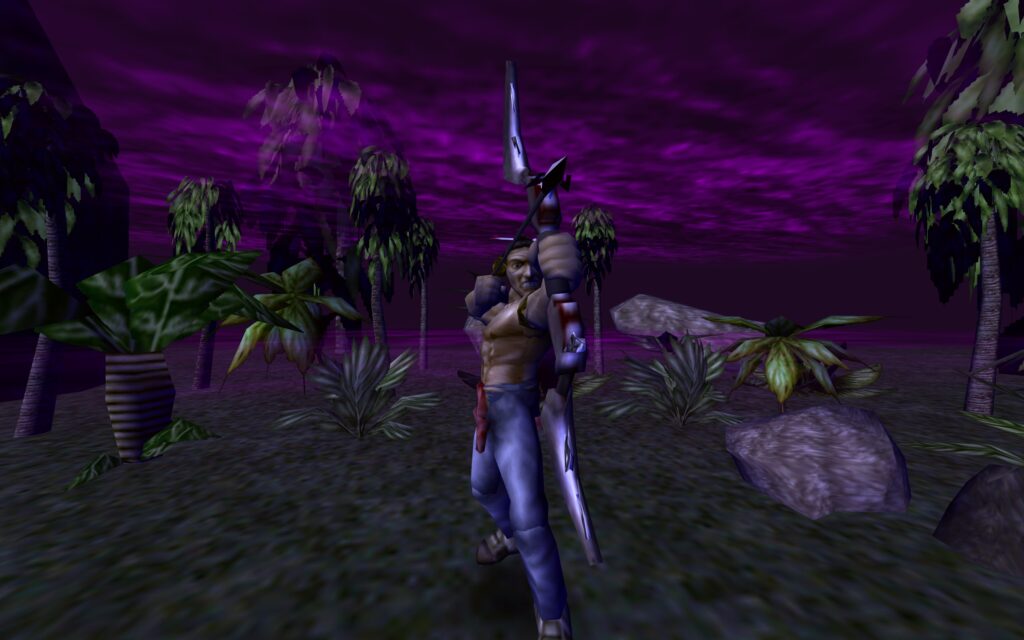
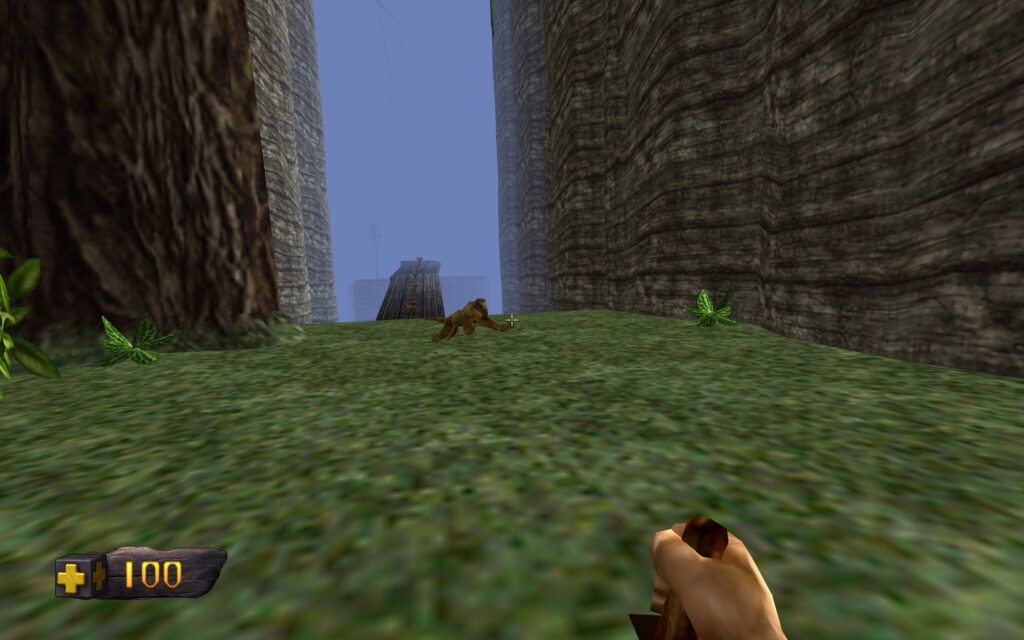
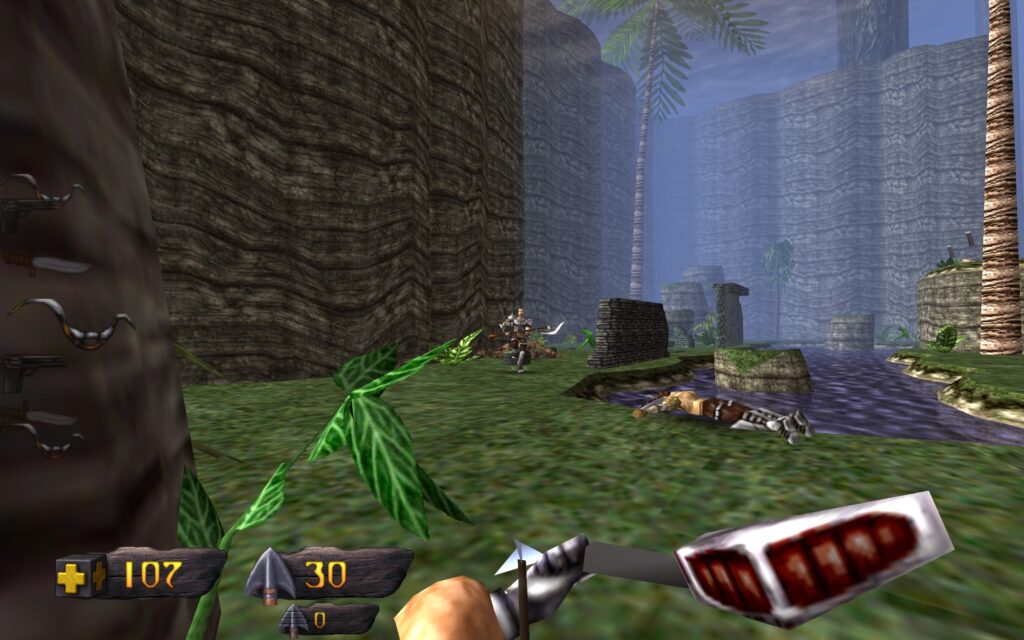
They haven’t updated the graphics themselves, however, leaving the original models, textures, and animations intact. While some players may want an upgrade to the visuals, this decision allows for both nostalgia and preserves the history of the game. It looks better, but almost the same as it did originally.
When Turok was originally released, many complained that the game would slow down when lots of enemies were on screen. With modern technology and the new engine, this isn’t a problem anymore. Turok: Dinosaur Hunter feels as smooth to play as any modern day FPS.
Story vs. Gameplay
Turok keeps its story simple. In fact, you could play through the whole game without knowing or understanding the story. This doesn’t make the game any less fun. It’s a “game game”, as in it focuses more on creating fun gameplay rather than telling a compelling story. You can read the story before you play the game, which will set the tone.
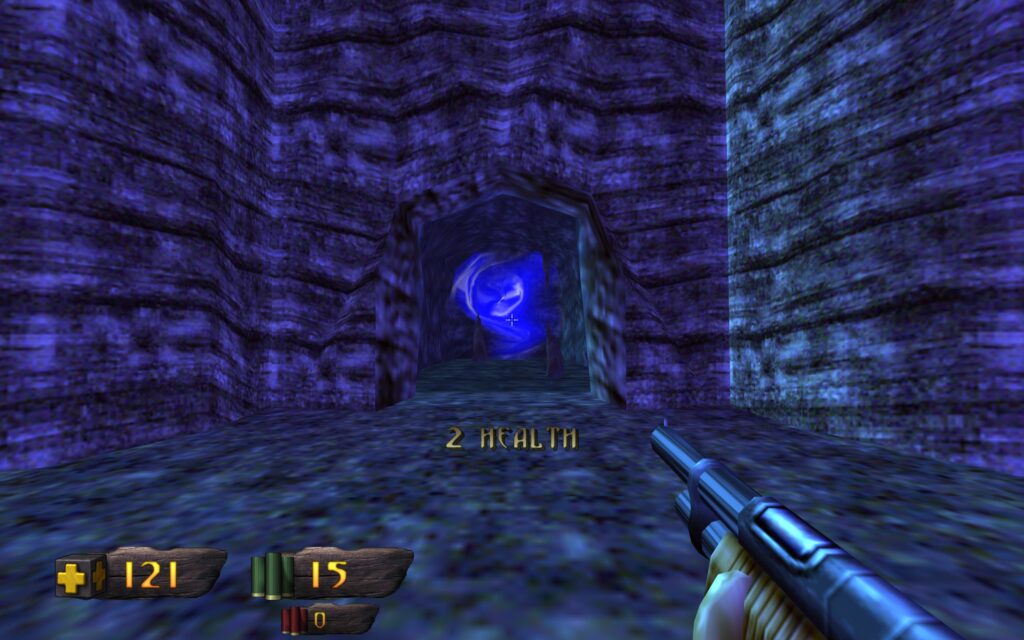
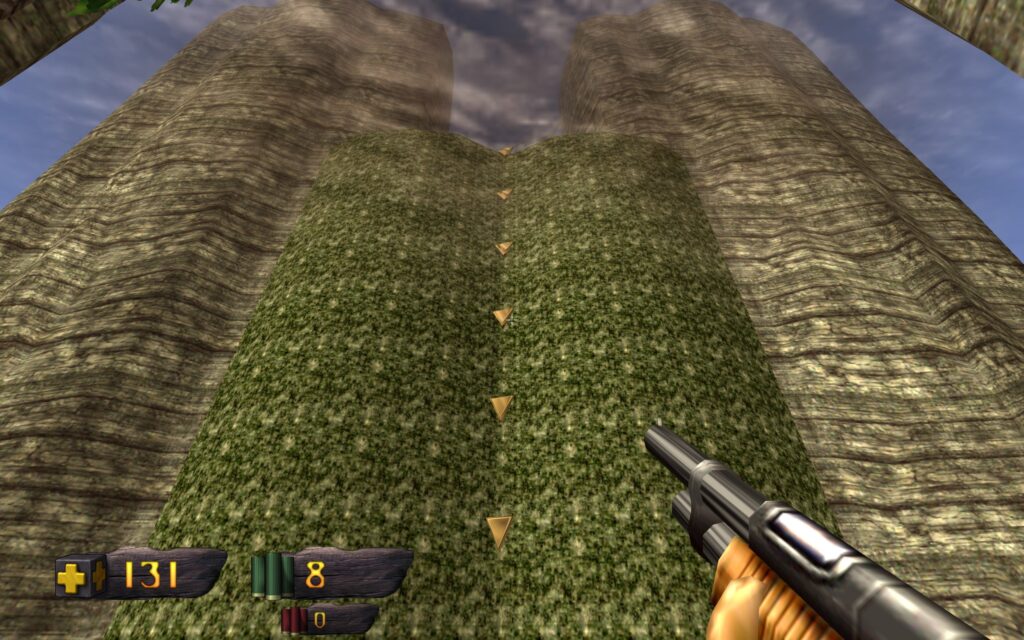
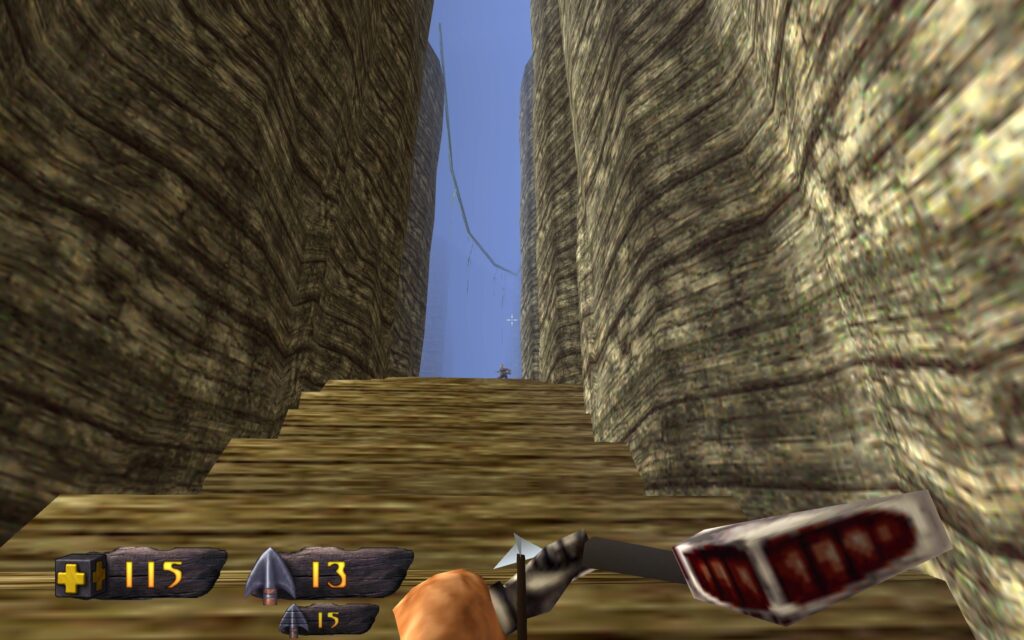
With that done you now have a reason to jump into the game and start shooting dinosaurs, among other things. You will explore different lands in search of the many keys and pieces of the Chronoscepter, before the final confrontation with The Campaigner.
Moving and Parkour
Moving Turok around the levels feels very smooth. As you strafe, Turok will lean slightly, giving a more natural feel to the movement. A common strategy is to strafe-circle1 enemies as in most FPS games of the time.
While movement feels very fluid, there are some small issues. It’s hard to tell exactly how close to the edge of a cliff you are, and the game is full of drops that will instantly kill you. There are many jumping sections that can be completely nerve-wracking, as a single misstep means instant death.
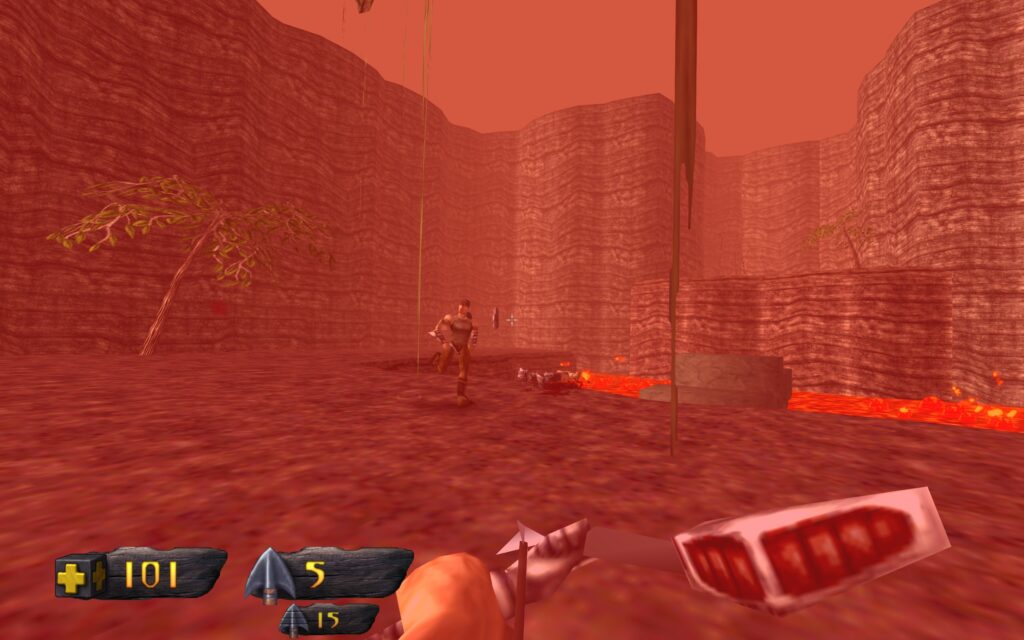
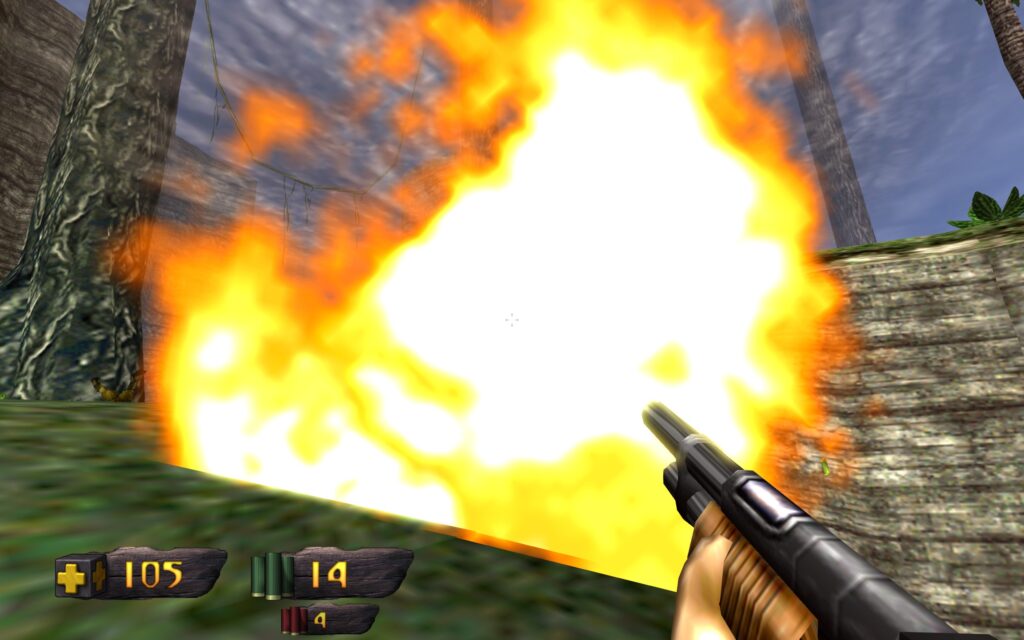
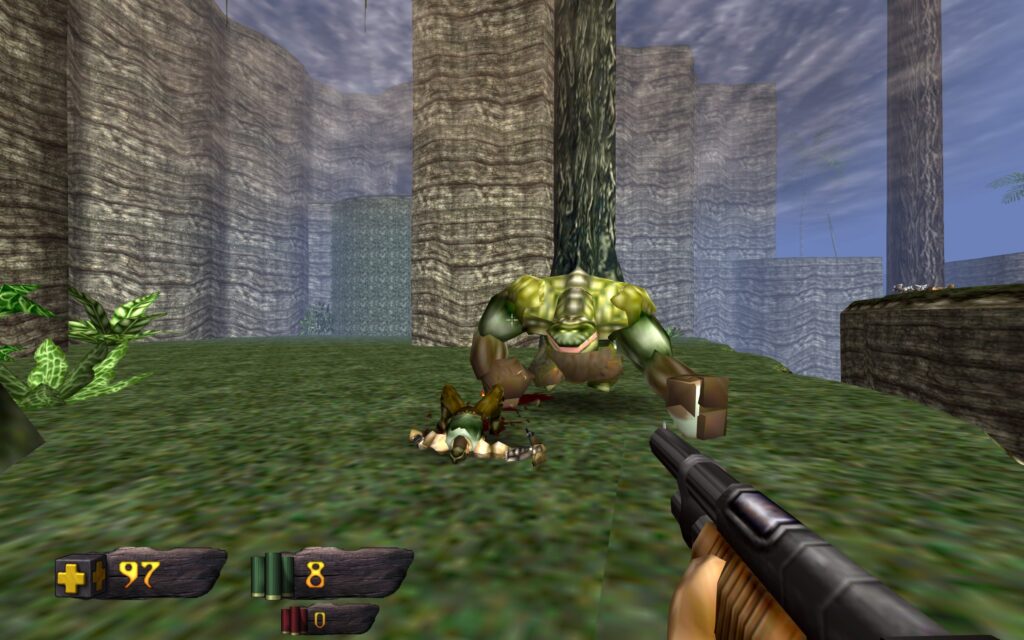
Still, you seem to intuitively get used to jumping, and I never felt a jumping section was unfair, even if it was challenging. One undocumented feature is the jump buffer: if you walk off an edge and start to fall, you can still jump once. This allows you to jump a little bit further and makes some jumps a lot easier to manage.
These sections may put people off if they just want to play a shooter, but parkour was an integral part of early FPS games. You can still see parkour’s influence in games like Mirror’s Edge, or in modern day Minecraft parkour challenges.
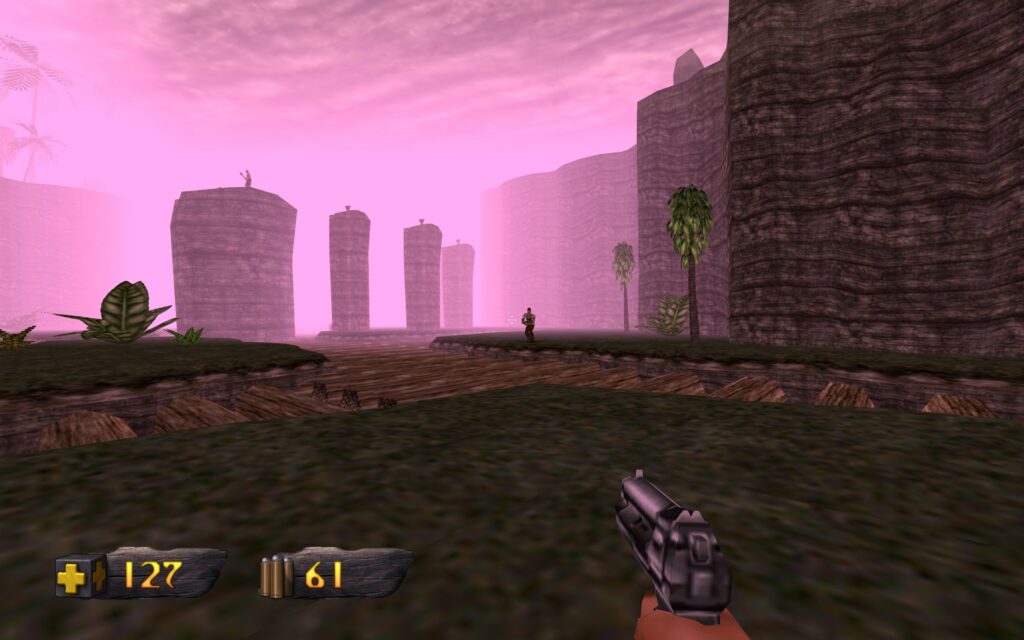
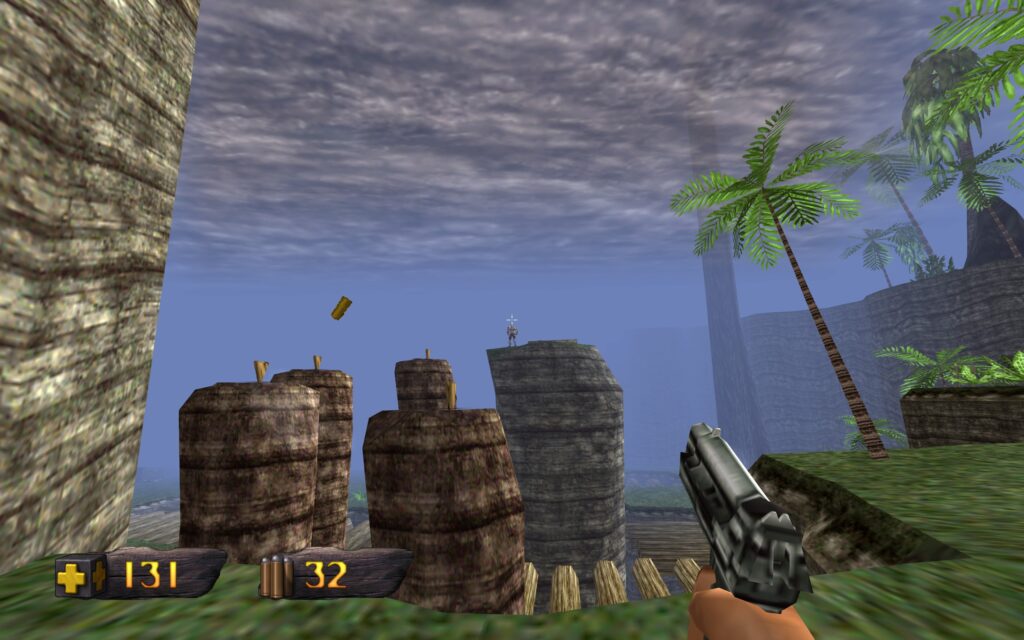
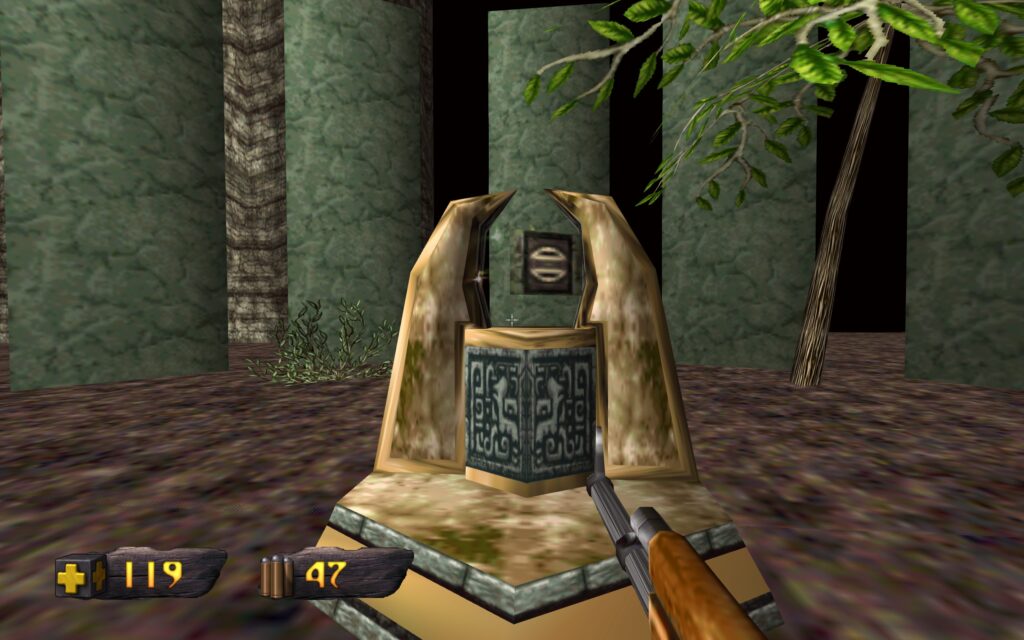
Turok can also swim, and hold his breath indefinitely. There are a few swimming sections in the game, required either to make progress or to find secrets. Swimming feels intuitive, although it took me a short while to figure out how to dive properly (you need to jump).
Levels and Their Secrets
The levels you will be jumping and moving around each have their own theme and structure. This isn’t portrayed simply with graphical updates, but in the designs of the levels themselves.
In one level you will be fighting through a jungle, trees scattered around with rivers you need to traverse. In another you will be climbing rickety wooden stairs and fighting through precariously placed treehouses. Or you will be fighting through a ravine, having to make several leaps of faith as you drop down from platfom to platform.
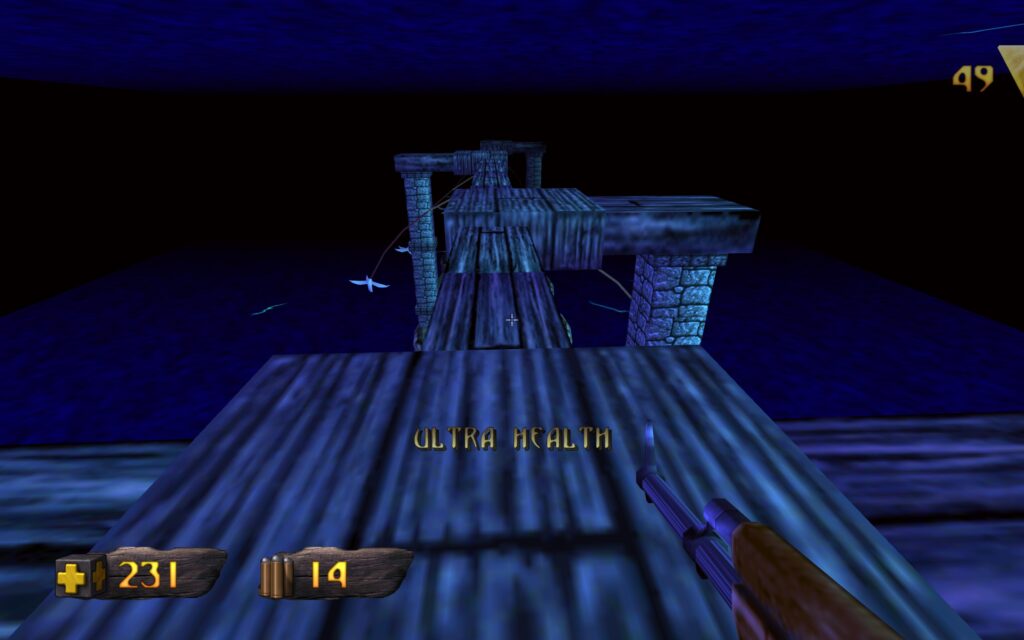
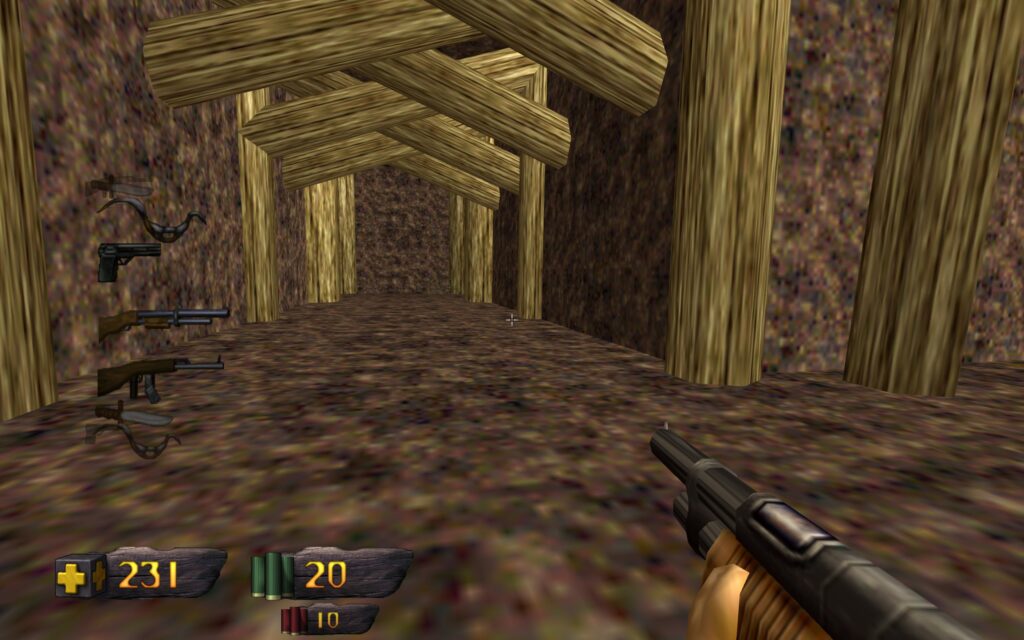
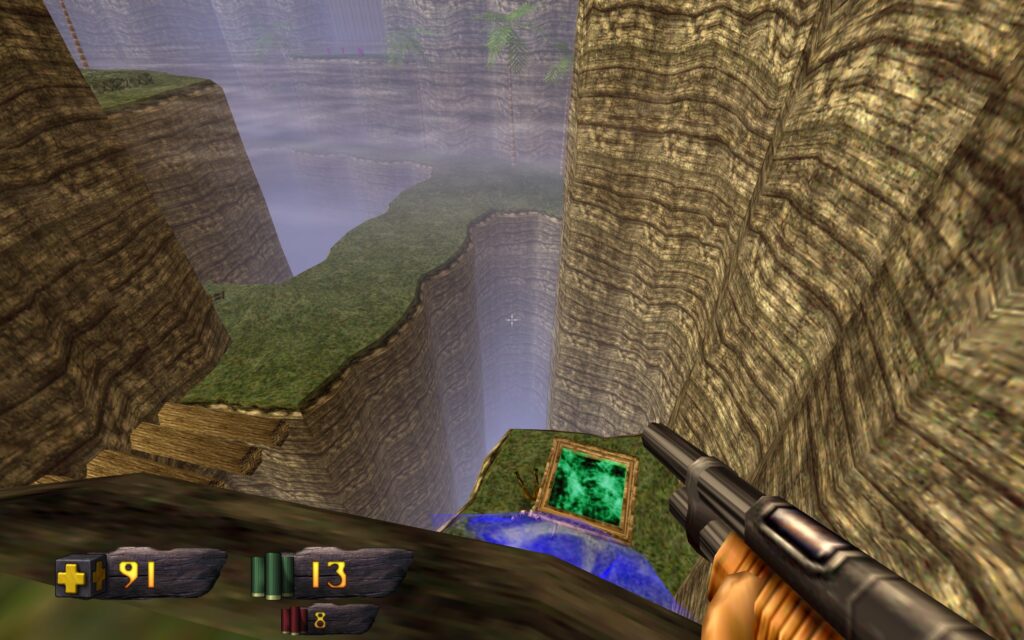
This kind of design, where the gameplay and the visuals complement each other, creates a unique experience with each level you play through. It gives you the motivation to find the keys scattered throughout each level, as you need these keys to unlock later levels.
You can freely move between levels from the Hub, a place that holds the portals to all the levels in the game. Each level has a portal at the beginning and the end that will teleport you to the Hub, almost giving the game and open world feel, despite the linear design of most levels.
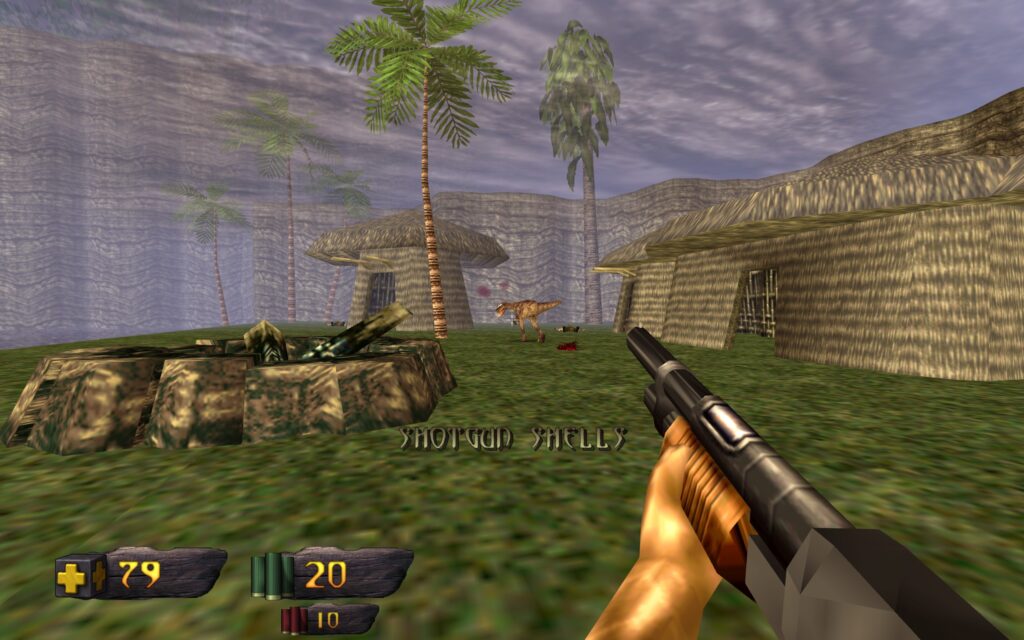
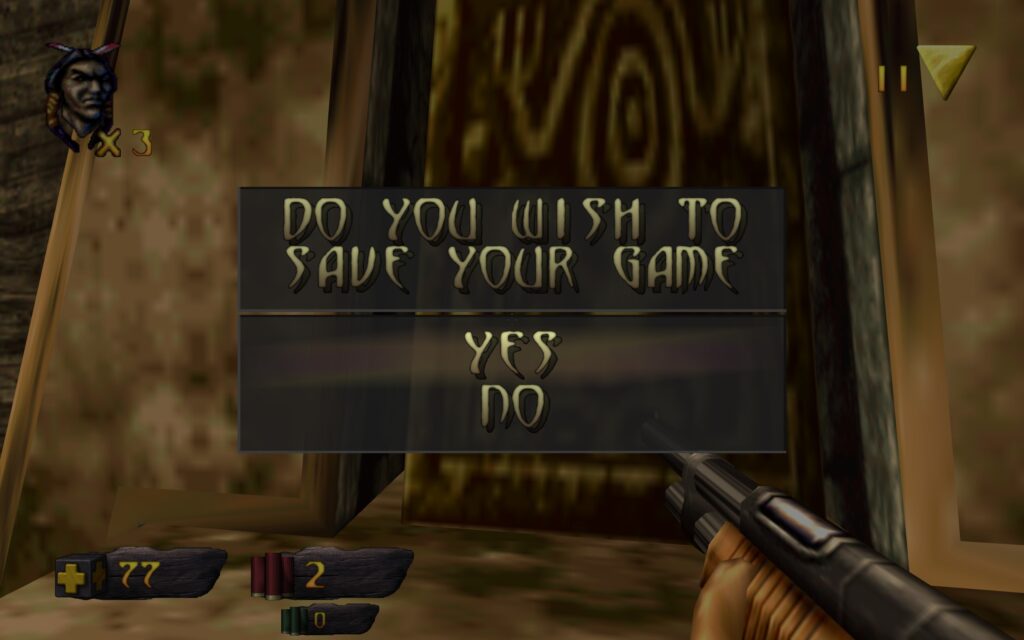
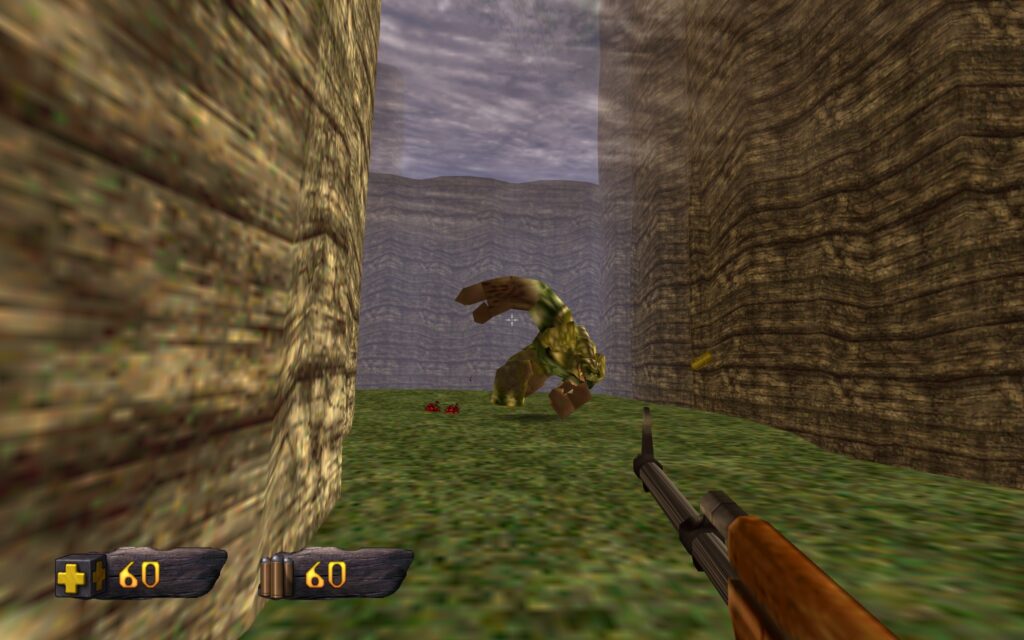
In most levels the placement of the keys are fairly obvious, but it’s possible to miss a key as you play through a level, forcing you to play through it again. Many levels are designed to feel like a maze, encouraging the player to explore. This maze-like design can be confusing to people, however, leading them to have to replay a level from the beginning if they miss something.
To keep things interesting, enemies will respawn. So if you do play through a level a second (or third, or…) time it won’t feel empty and barren, though you may want to think about conserving your limited ammunition. It doesn’t add anything new, but at least maintains some challenge when replaying a level.
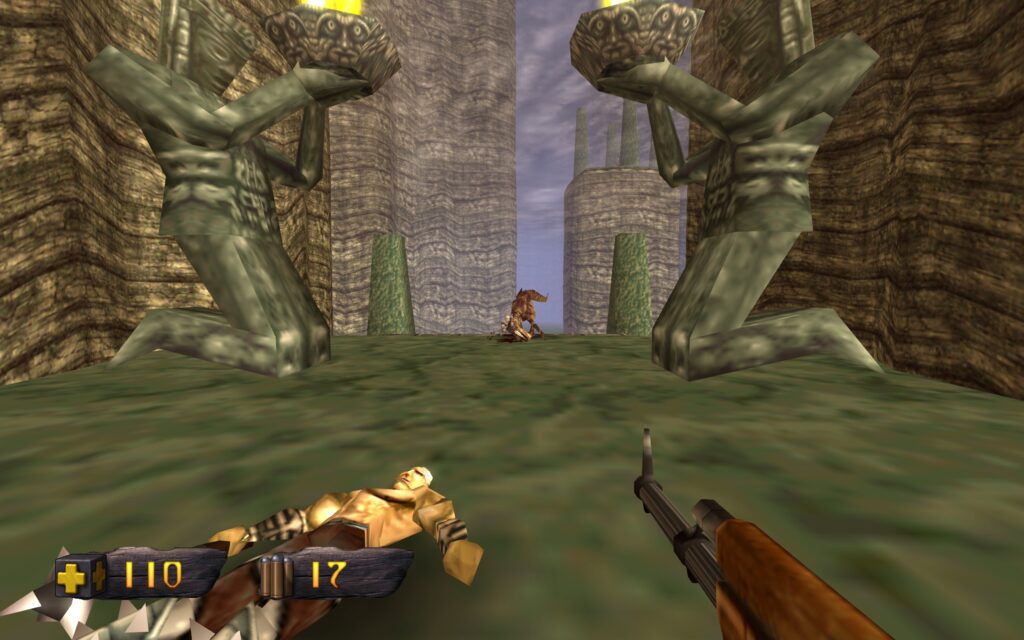
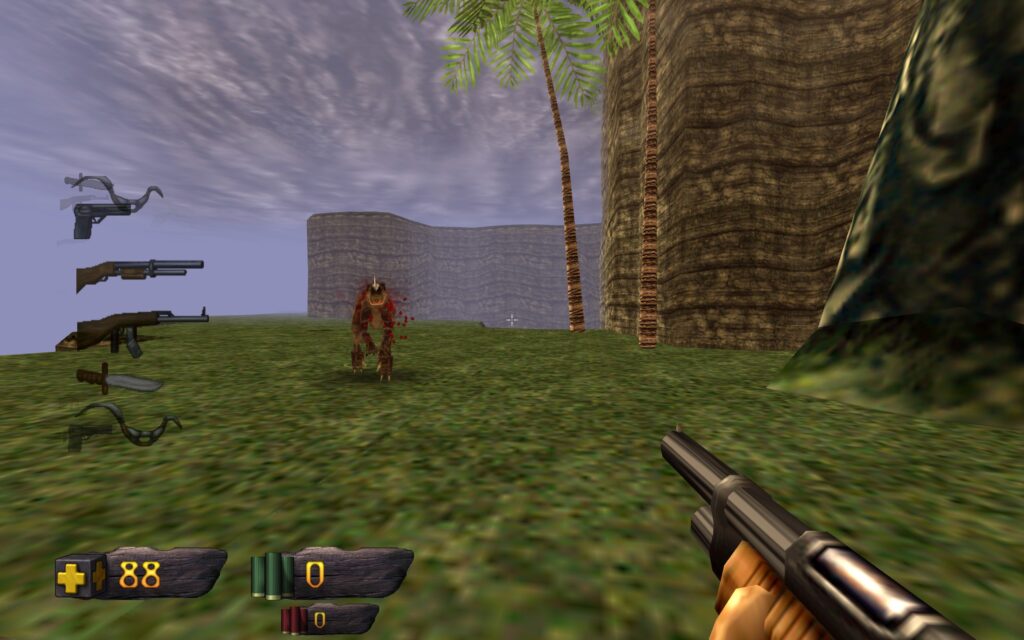
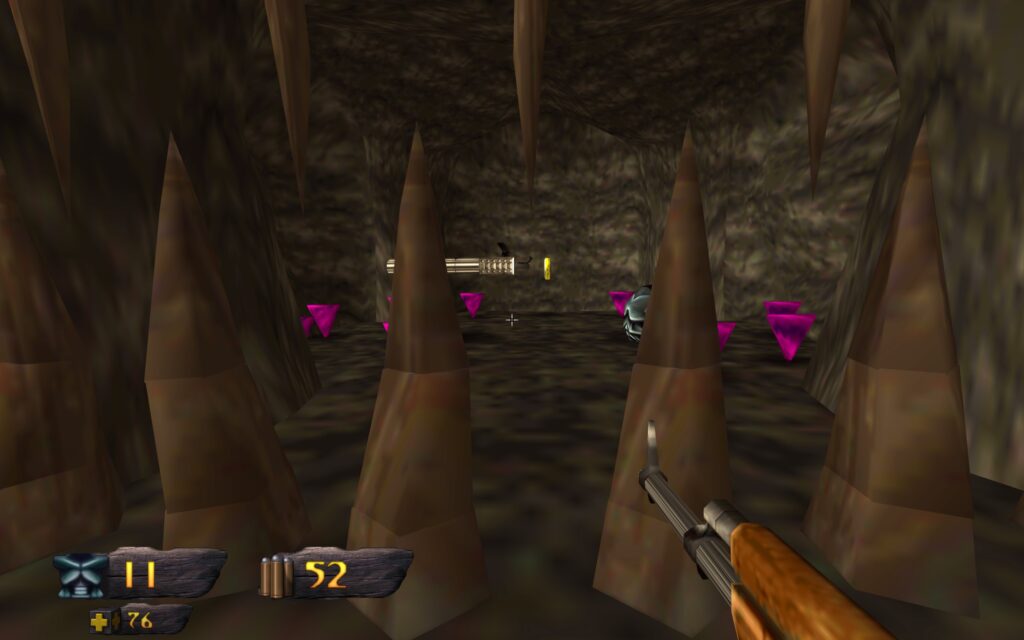
All levels have secrets, and while some are obvious, others use the old method of a wall you happen to be able to walk through. One insidious secret is water disguised as lava. You think you will take damage if you jump in, but if you do by chance you will find you can swim through and find a Chronoscepter piece.
This kind of hidden secret design was extremely common in games all the way through the 90s, but has become less popular as designers feel it was unfair. This may put modern gamers off, but there isn’t anything preventing you from completing the game if you don’t find these secrets.
Atmosphere
Turok’s sound design is what made the game stand out in 1997. Howls from various hidden creatures in the jungle, wind rushing through canyons, trees breaking and falling after they are blown apart. This is accompanied by a soundtrack that is reminiscent of both journeying the jungle and the tribal sounds of Native American culture.
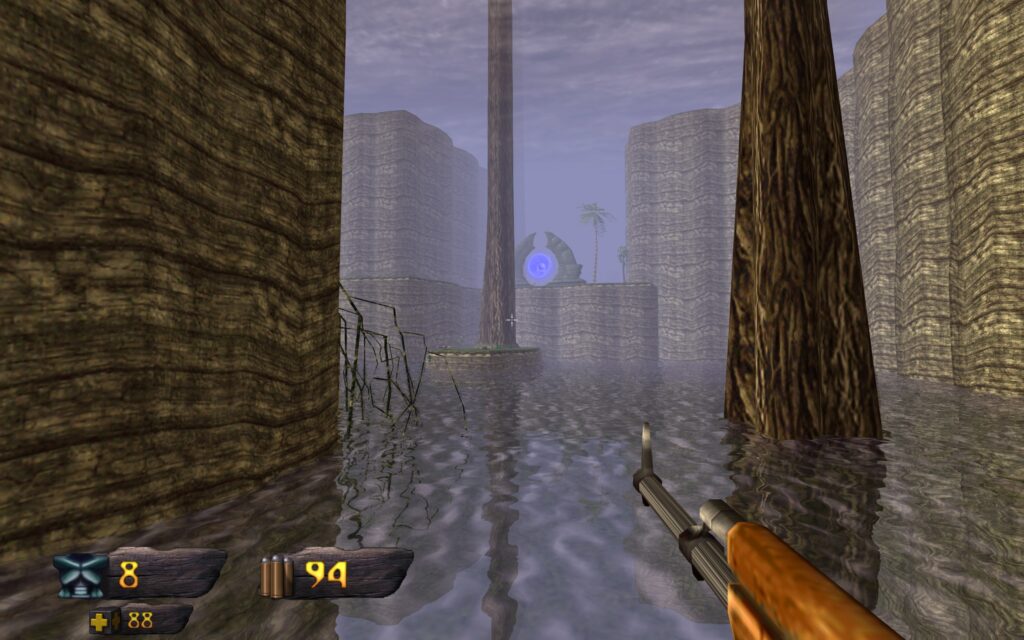
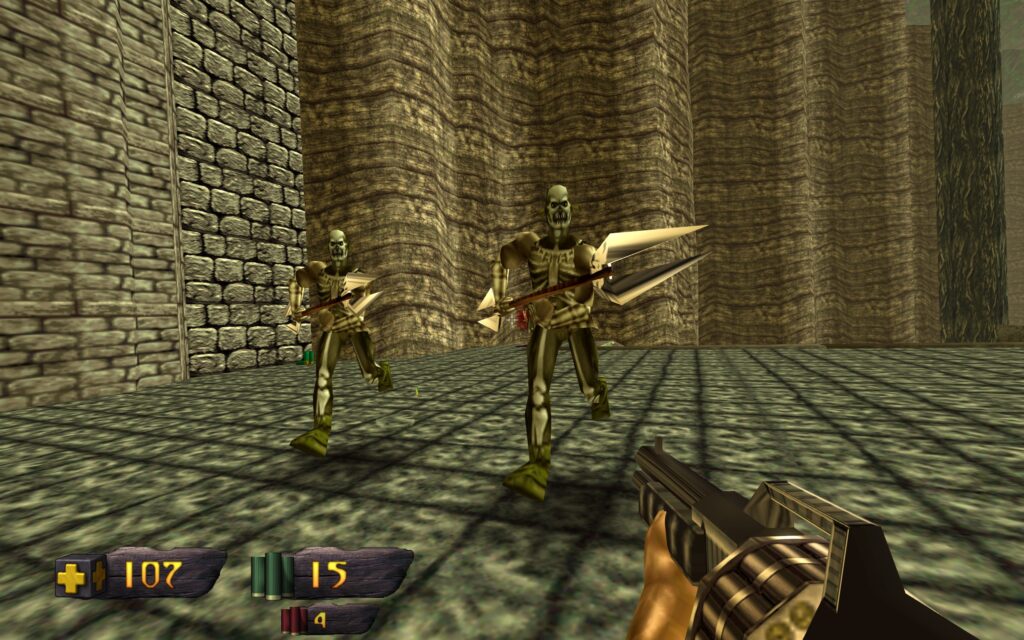
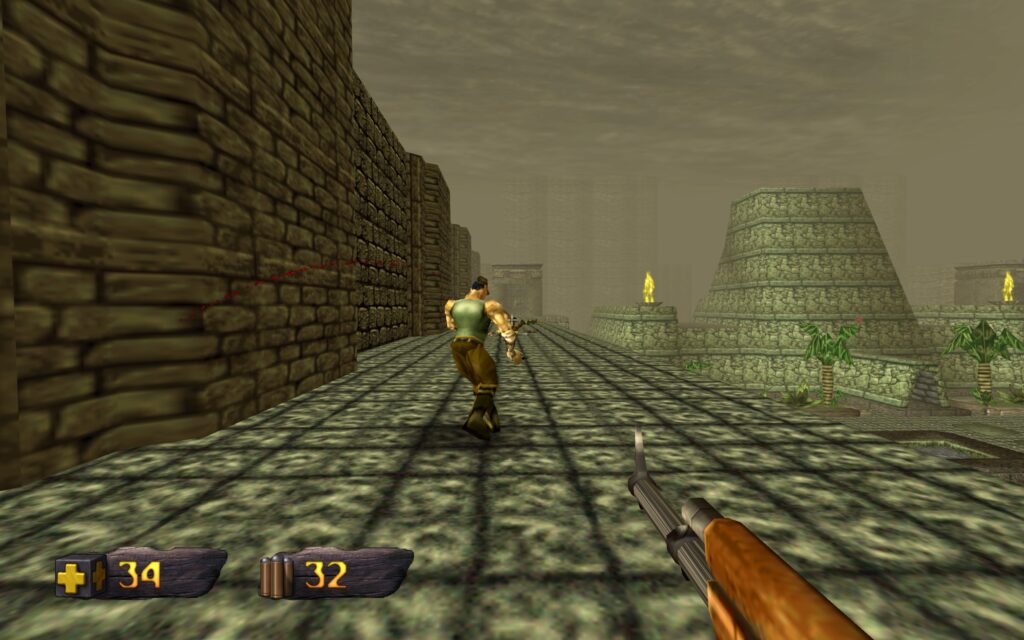
The levels are also populated by various peaceful animals wandering around. You can “hunt” these enemies: attacking them will drop small health boosts to heal you character. They put the “Hunter” in “Turok: Dinosaur Hunter.”
A moment that stands out is when you are climbing the trees and you see brachiosauruses heads poking through the fog as they wander past, unaware of the battle you are fighting. These small elements build the atmosphere of the game, immersing you into the feeling of climbing down a canyon, or leaping across the trees, or working you way through a hi-tech alien facility.
Enemies and Bosses
Of course, levels aren’t just about walking and jumping. You have to fight your way through a slew of enemies if you hope to beat the game. Turok was sold on the premise of hunting dinosaurs, but the enemies in the game are actually extremely varied.
You will fight raptors, triceratops, and even a fire-breathing T-Rex; but you will also fight human enemies, alien beings, robots, mech-warriors, giant bees, huge underwater crabs, and a host of other enemies. Each opponent has their own unique behaviours, forcing you to adapt your strategy as you fight through the game.
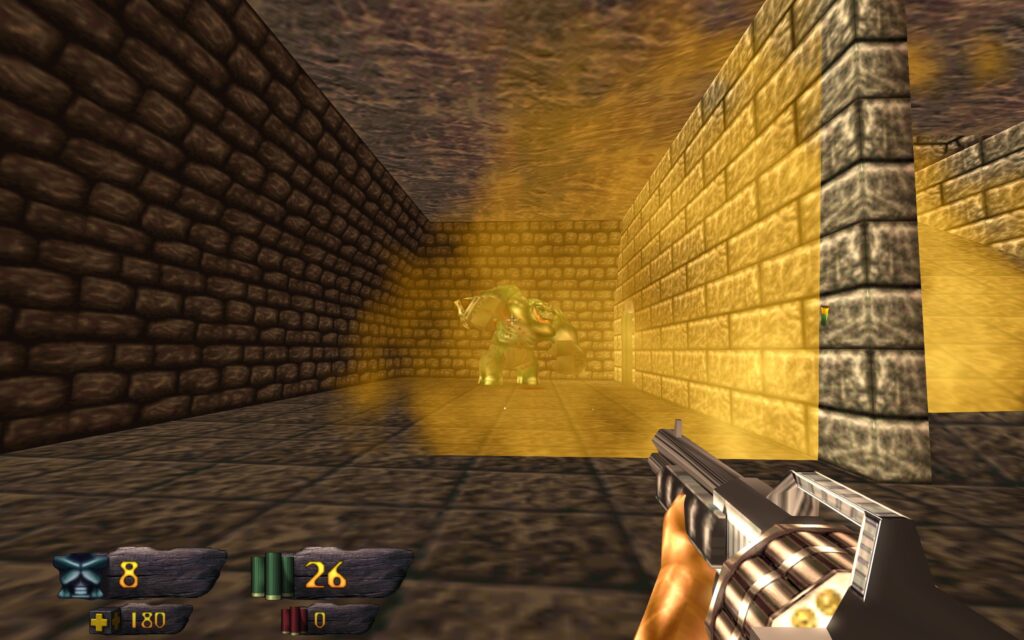
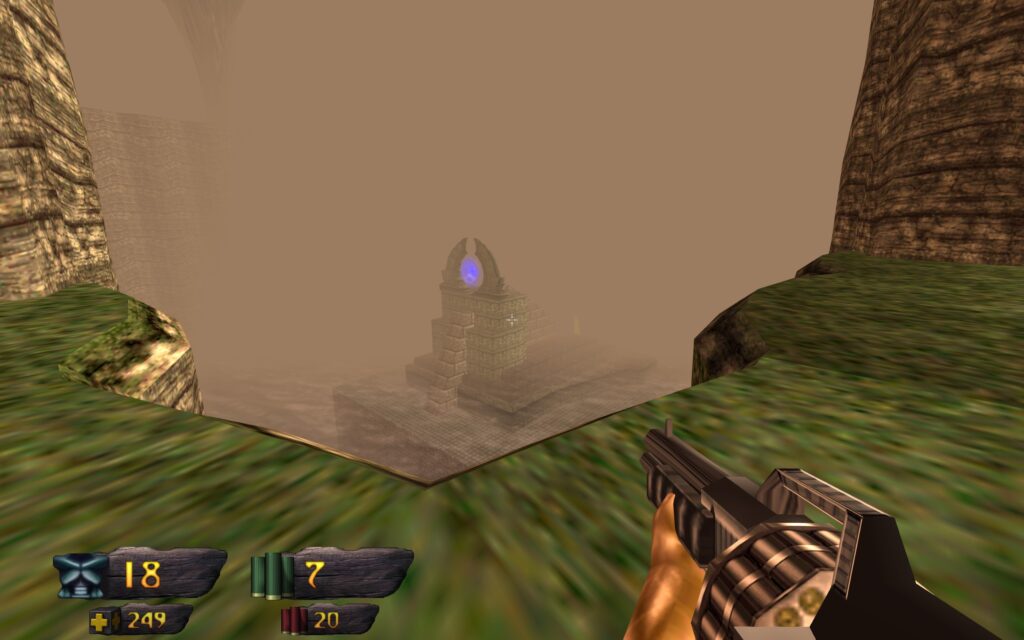
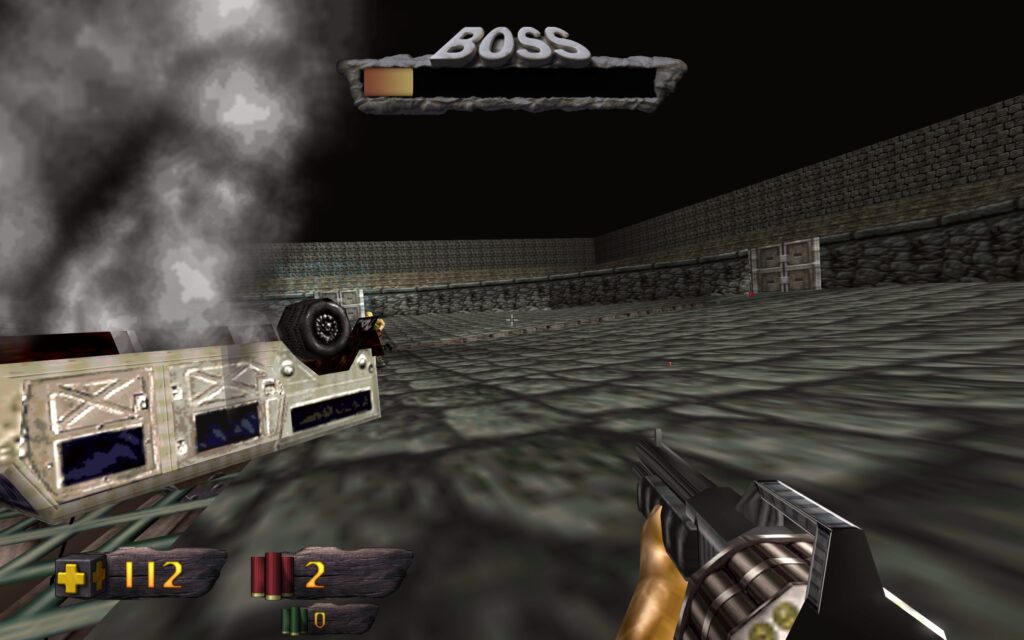
While you could say the AI isn’t as advanced as modern day games, it doesn’t feel any less advanced while playing. Enemies stay challenging throughout, pushing you to use every weapon in your arsenal.
At the end of several levels you will have to fight bosses, which each provide their own challenges. You’ll be avoiding fast moving hum-vees on one level, trying to avoid a giant flying insect smashing through walls in another, or fighting the aforementioned fire breathing T-Rex with fricking laser beams attached to its head. The variety in these bosses creates fun challenges that some may still appreciate.
Shooting at Things
Speaking of weapons, you don’t have much of a shooter without things to shoot. Turok starts with a knife and bow, weapons that feel as primitive as they look. The bow takes time to draw, but you can hold the string taut until you are ready to release.
You will gain other weapons as you progress, from realistic weapons like a pistol, assault rifle, shotgun, or grenade launcher; to more science-fiction style pulse rifle, particle accelerator, or quad rocket launcher. Each weapon feels unique to fire, each doing damage in slightly different ways. For example, an assault rifle fires, short three-bullet bursts, whereas the minigun requires a short time to start spinning before it send bullets ripping through enemies.
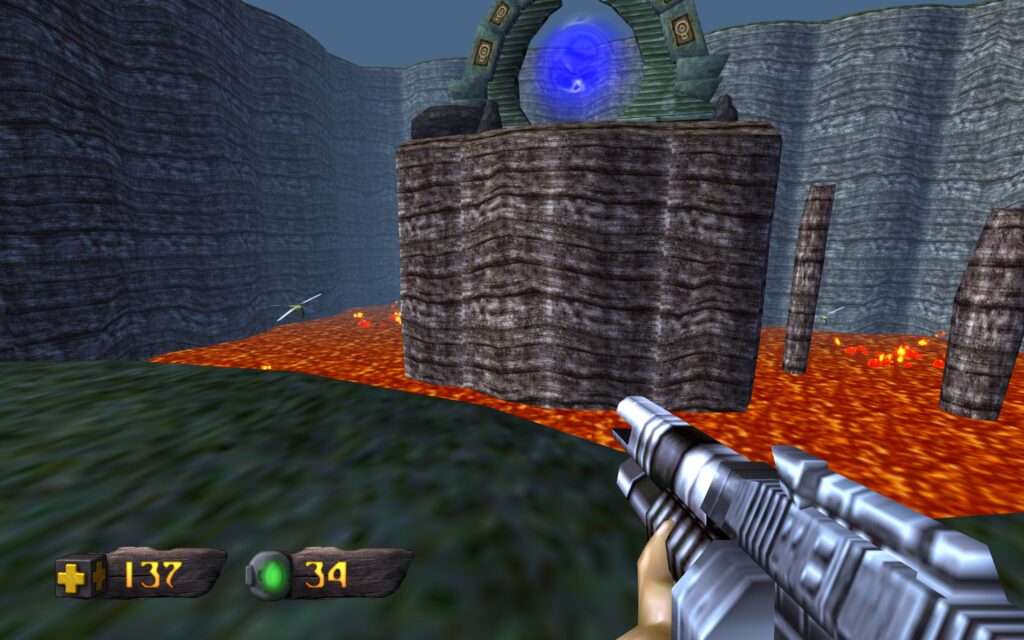
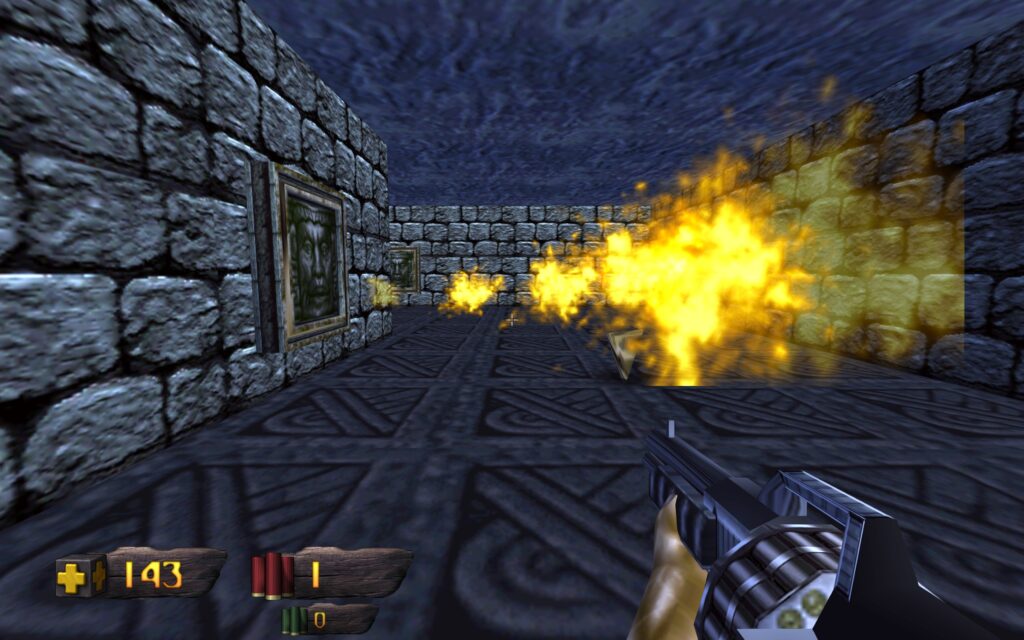
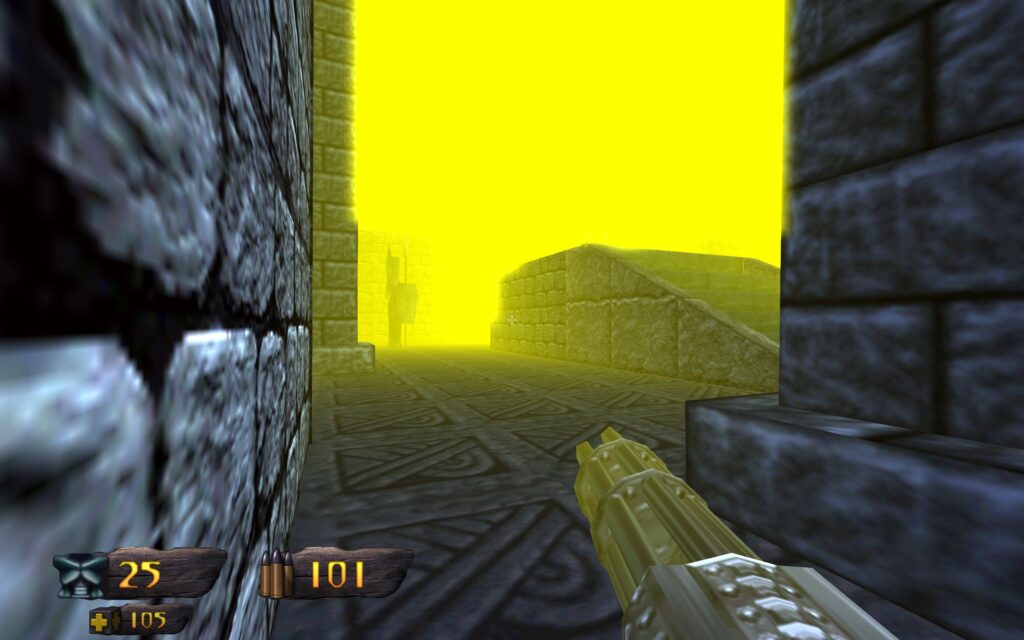
There’s no alternate fire for any of the weapons, though a couple do have alternative ammo you can switch to. The shotgun has the more damaging explosive shells, and you can get really powerful Tek Arrows for the bow. You can’t carry many of these arrows, but they are highly explosive, highly damaging, and can save you in a bind.
Part of the fun of Turok is playing until you find the next weapon and figuring out how to use it effectively. It’s another thing that motivates you to keep playing: you’ll be rewarded with new toys that will let you kill enemies more efficiently.
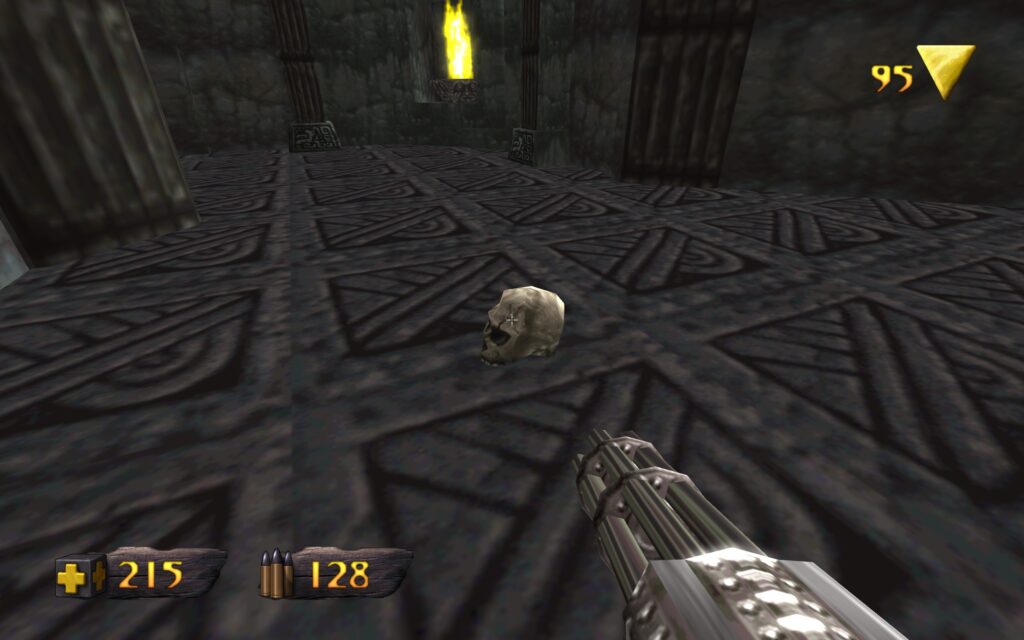
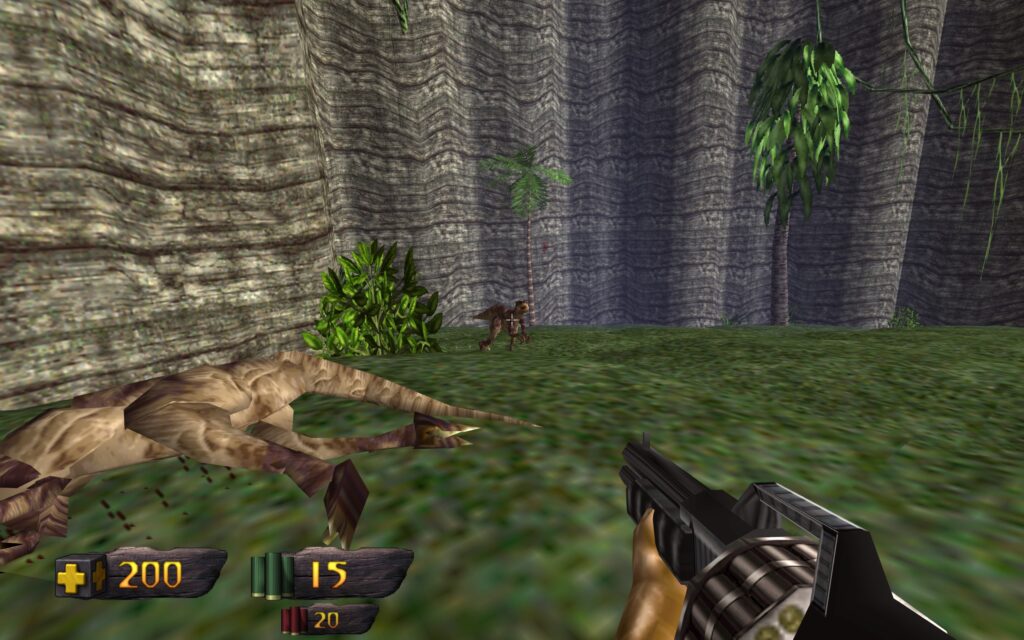

Unfortunately, the collision detection for weapons isn’t always reliable. Often, you will hit a corner of a wall when it looks like you have a clear shot at an enemy. This can be especially annoying with an explosive weapon like a grenade launcher, leading you to take damage instead of sending a grenade toward an enemy. It’s not a game-breaking issue, but it can occasionally be annoying.
Saves and Lives
In Turok you cannot save anywhere, and you don’t always respawn on death. There are save points throughout each level where you can save, and this will be where you start if you leave the game and come back later. There are also Checkpoints, where you will respawn when you die. Save points also act as Checkpoints, so you can respawn there as well.
But you cannot simply respawn indefinitely. You have a limited number of lives, and if you lose them all, you die and the game is over. To gain more lives you have to collect 100 Life Force Tokens, which are scattered around every level.
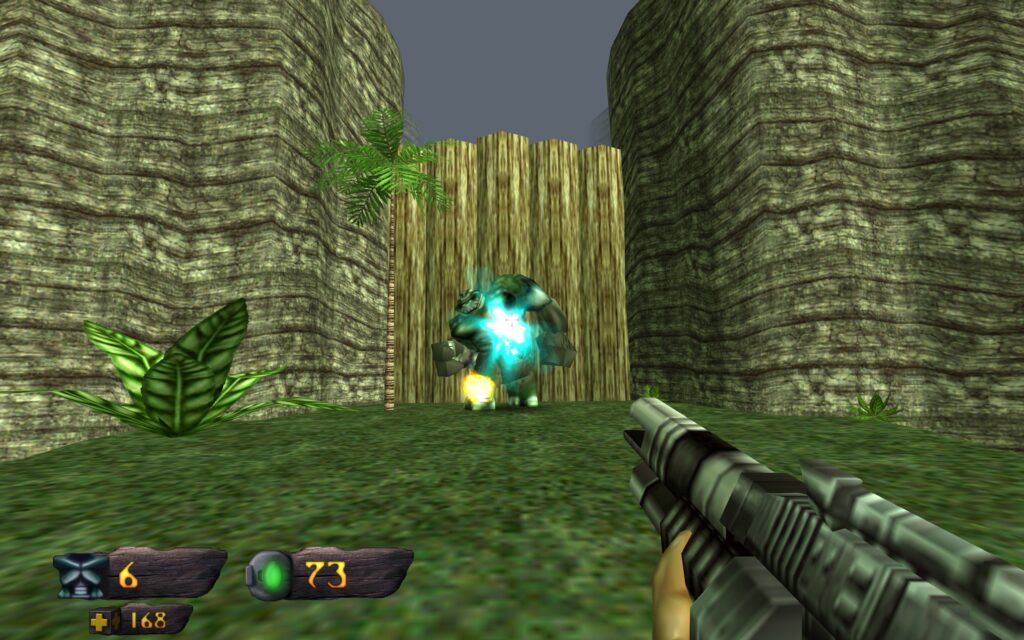
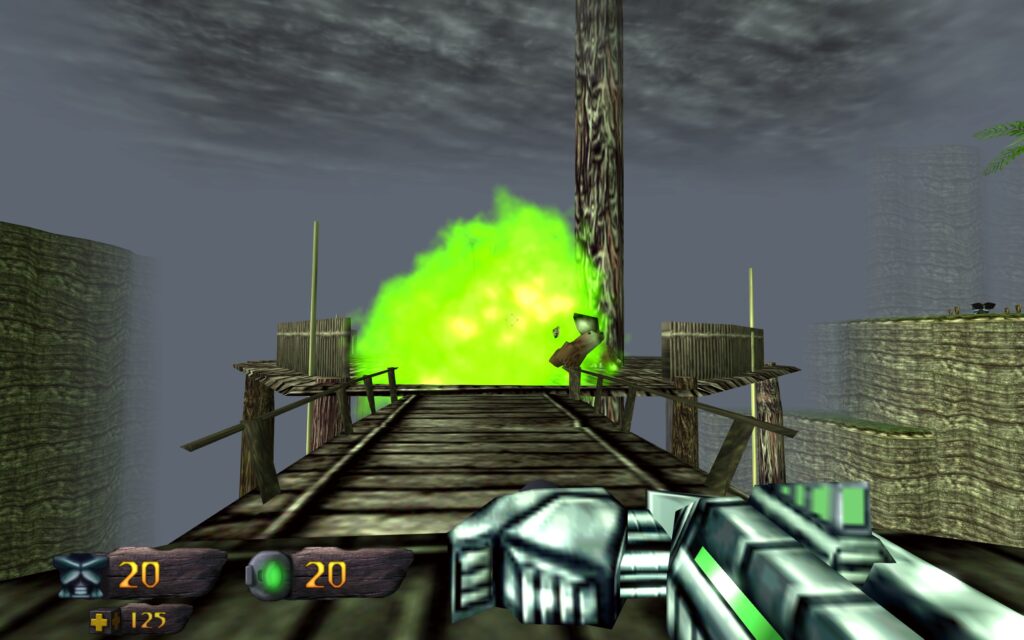
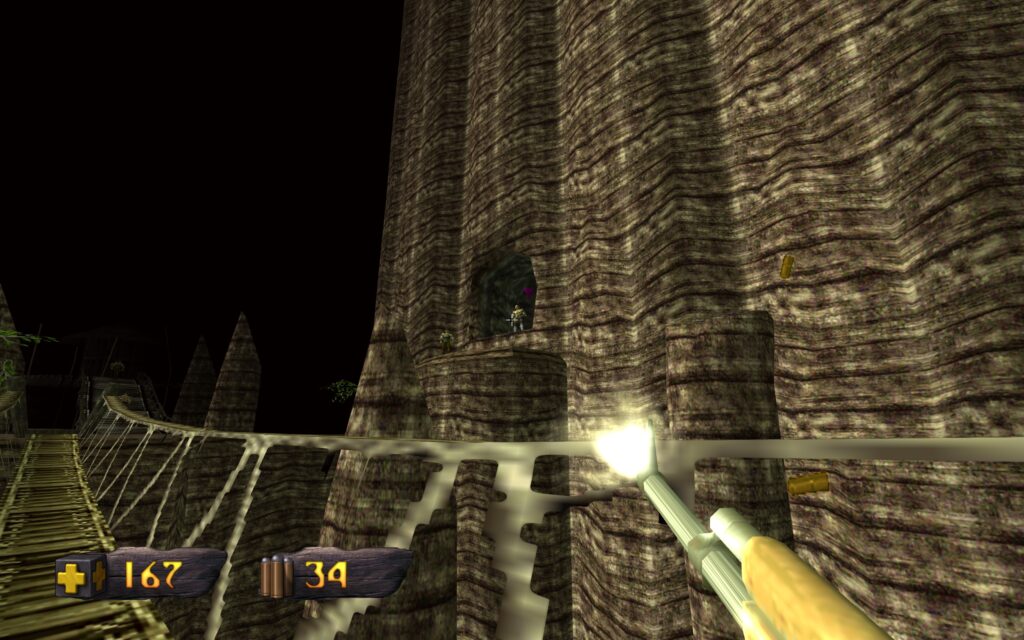
It gives you a little more motivation to stay alive, and gives you something else to collect. Many Life Force Tokens will be in hard to reach places or hidden in secret areas, but you may be motivated to reach them if your lives are low.
Of course, this system can be cheesed slightly by reloading a save instead of respawning, but it still adds a little extra challenge compared to games that allow you to save everywhere, or give you infinite retries. Some modern players may appreciate this added challenge, while others might find it frustrating
Conclusion
Across its levels, Turok keeps players engaged with its mix of exploration, platforming, and intense combat. While its maze-like structure and limited save system add a layer of challenge, the satisfaction of mastering its mechanics makes the journey worthwhile. But how does it compare to other shooters of its era, and is it still worth playing today?
It doesn’t look as good as Quake, which came out a year prior. Turok also suffers from its more open level design leading to repetition, whereas Quake had a clear, simple route through each level. But Turok shines when it comes to the unique look and feel of each level, as well as the design of the enemies and boss fights.
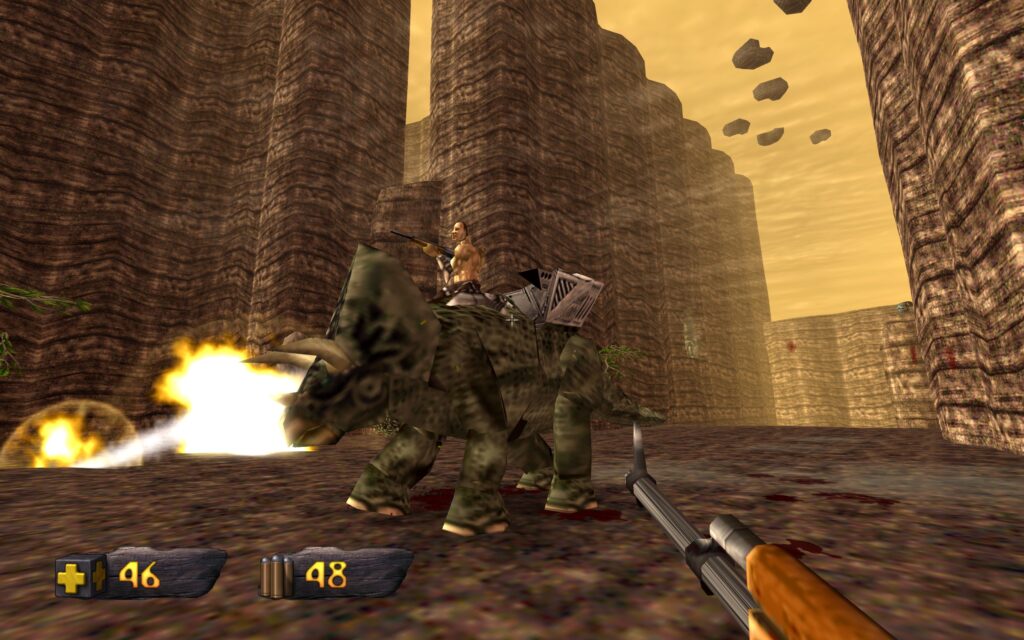
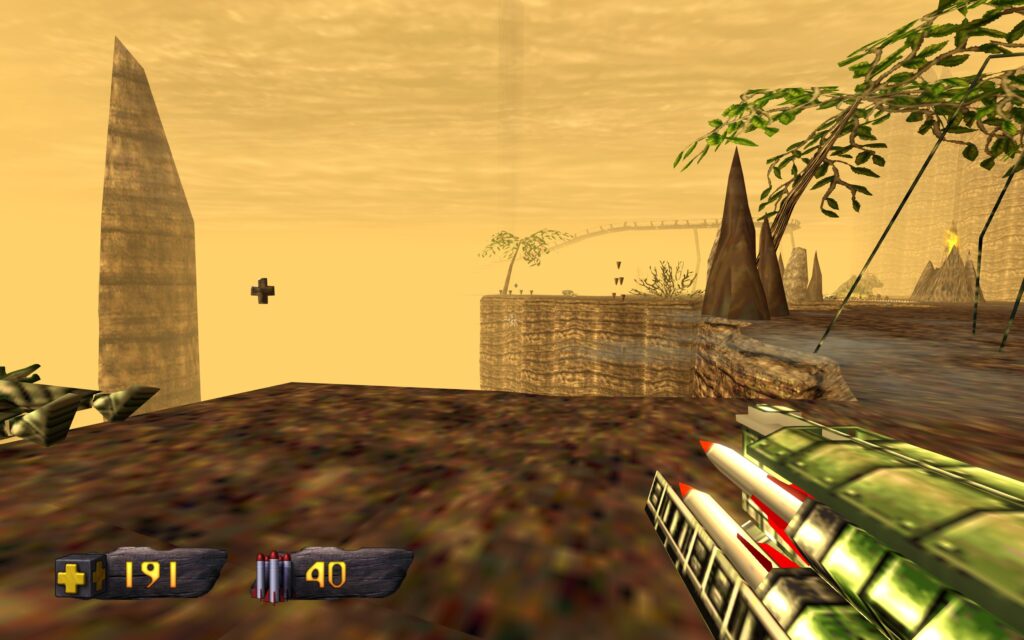
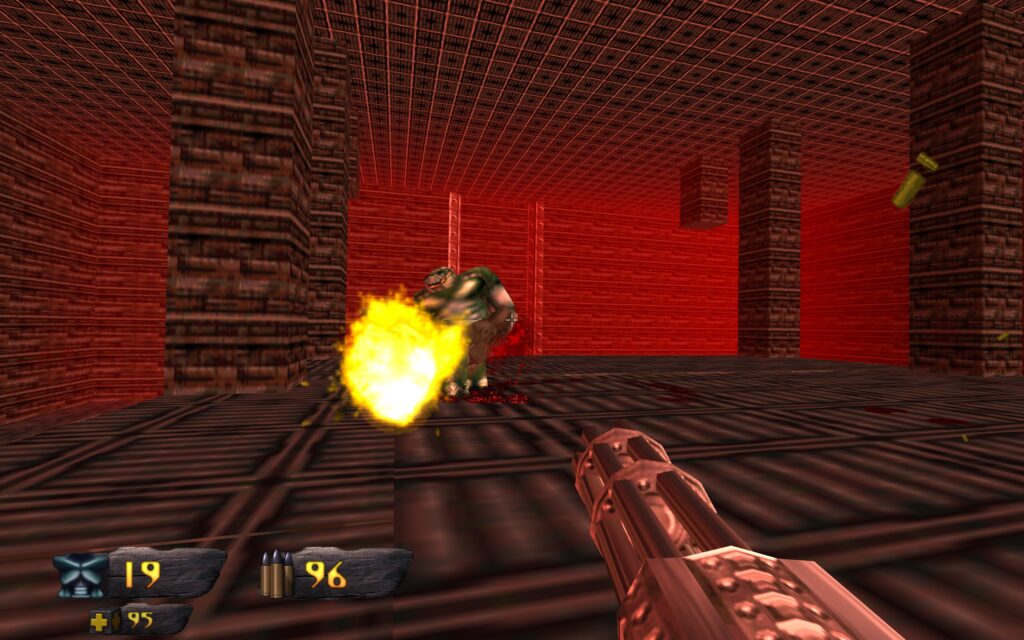
Goldeneye would release later in the year and, while it doesn’t pit you against dinosaurs and aliens, it would provide a much more polished experience that truly made you feel like you were playing a James Bond movie. While Goldeneye has a stronger legacy today, Turok would still maintain a franchise that lasted several games.
Turok: Dinosaur Hunter remains today what it was in 1997: flawed, yet undeniably fun. Its maze-like levels and platforming sections might frustrate modern players, but its fluid movement, unique level variety, and satisfying gunplay keep it engaging. If you can embrace its quirks, Turok still delivers a wild, nostalgic thrill ride worth taking.
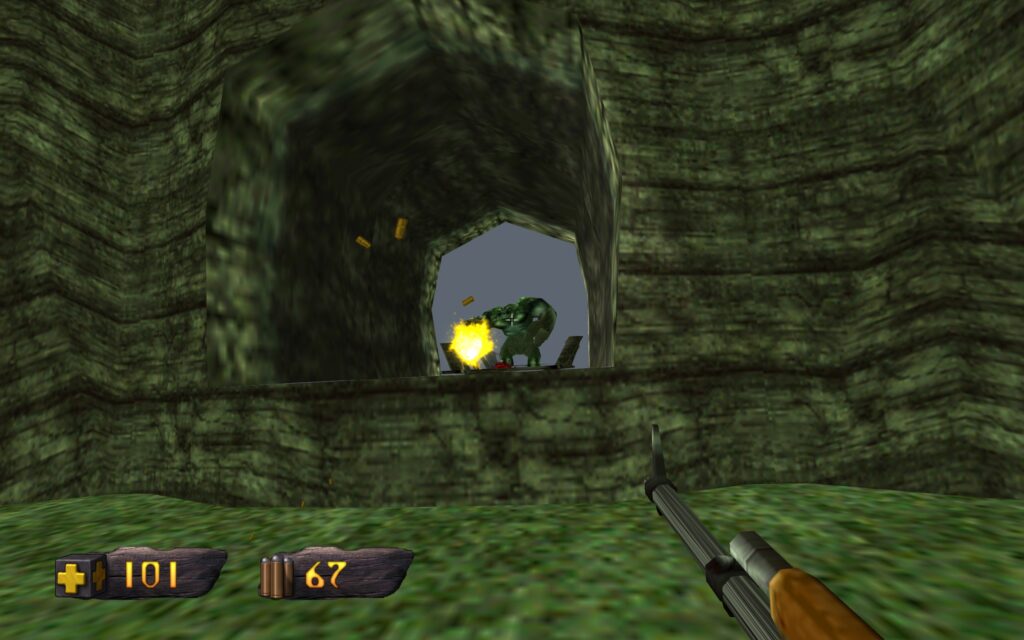
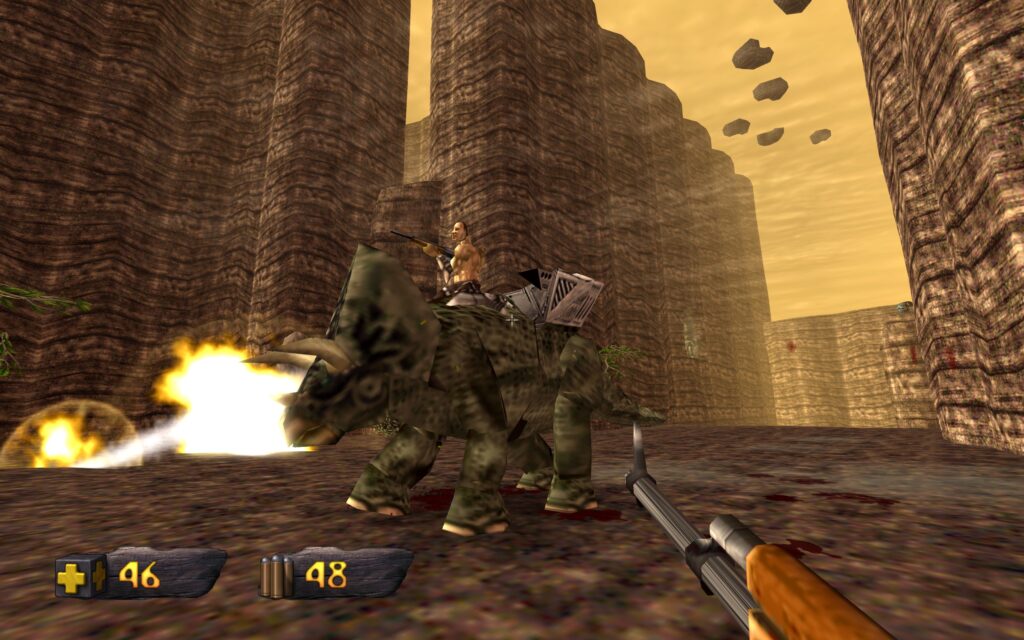
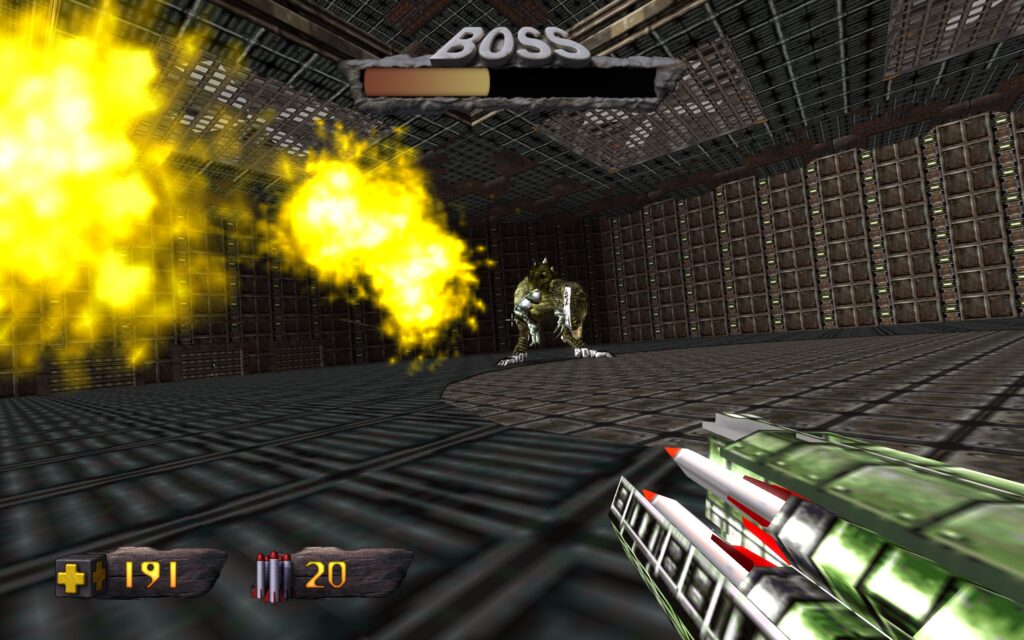
Whether you’re revisiting a childhood favorite or experiencing it for the first time, Nightdive’s remaster ensures Turok: Dinosaur Hunter still feels like a thrilling, action-packed adventure.”
- A method where you move sideways in a circle, keeping the target in your sights, while making yourself harder to hit. ↩︎




